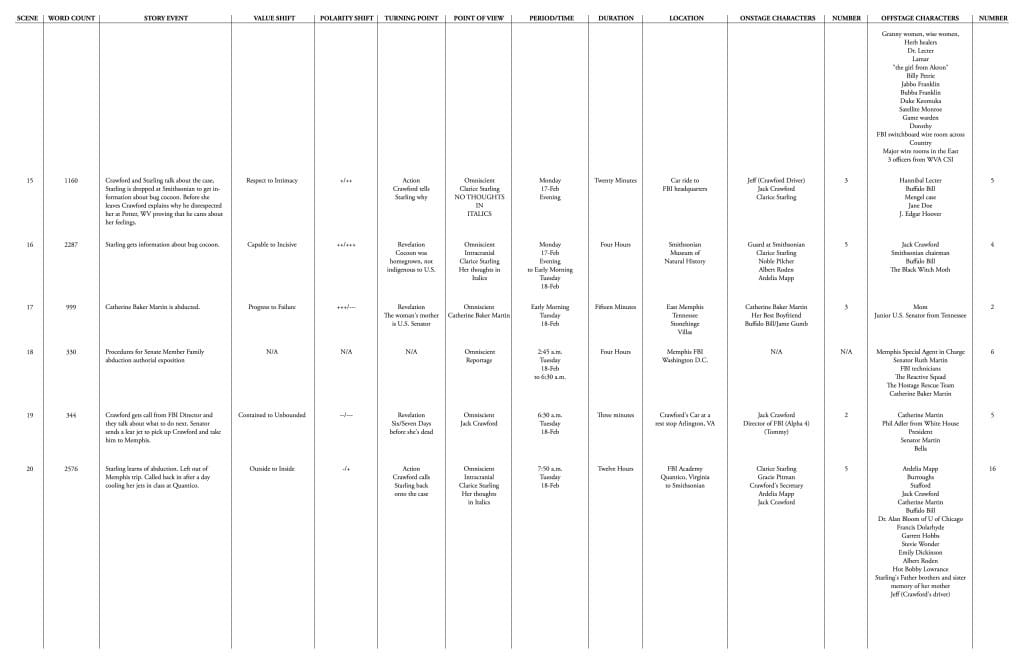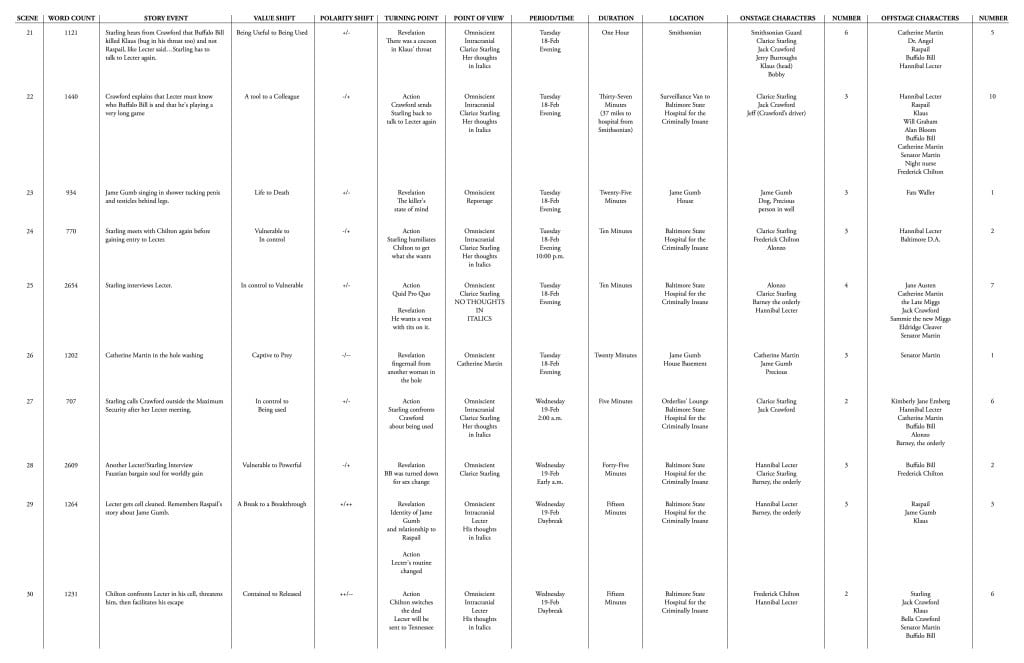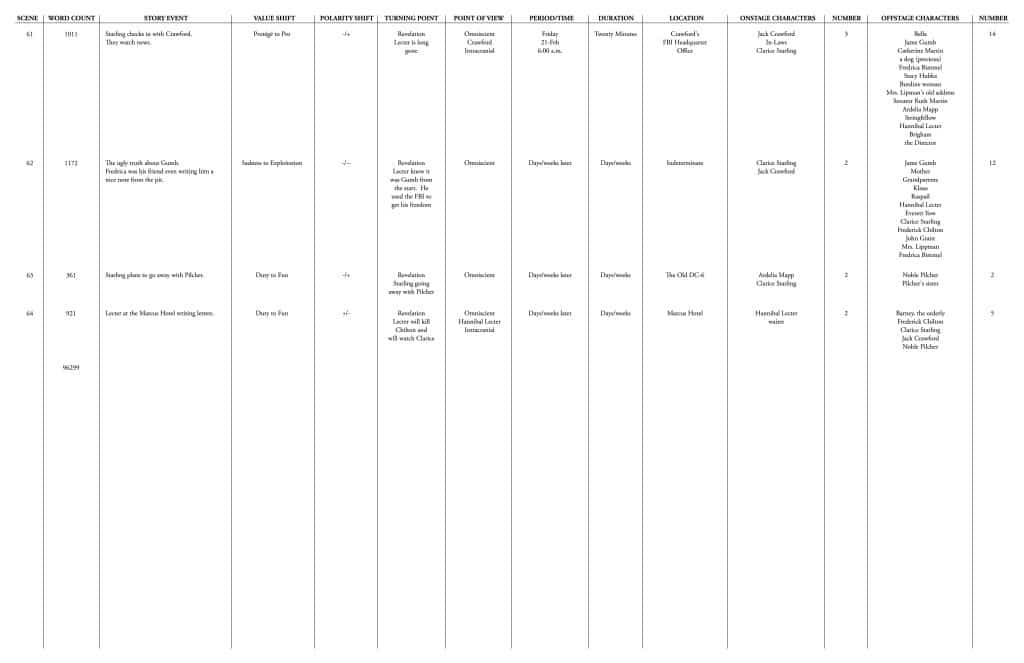The last six columns in The Story Grid Spreadsheet concern story continuity.
These are important to track so that you keep all of the setting, time, and character entrances and exits in sync. On the screen, continuity glitches can take the viewer right out of the experience. We’ve all seen movies where a character is smoking a long cigarette in one scene. And then the shot cuts to another character and then back to the cigarette smoker who is now holding a drink with no cigarette in sight. It’s distracting and lazy on the part of the director to allow that kind of screw-up. The same thing can happen in a novel or play.
The Story Grid Spreadsheet is the place to keep track of all of the little details that can sabotage the finest of stories.
Again, this is pure analytical labor. It takes serious concentration. So, I’d suggest doing only a limited amount of this work per day. Set a goal to do ten scenes and then shut it down and walk the dog. You can get seriously hinky if you try and knock off these details in a day. Take your time. The more accurate the spreadsheet is, the more helpful it will be.
Here are the column headings with brief descriptions:
Point of View is the vantage point from which the reader/viewer sees the fictional world. Thomas Harris uses nine different points of view in The Silence of the Lambs. Where he chose to switch points of view were critical decisions. The way you choose to approach POV is no less crucial.
Period/Time is simply the time of day, hour, weekday, month or year that the scene is taking place. For example, Late Afternoon, Thursday February 6 is a very specific period and time designation. The more specific you are with the period and time in each of your scenes, the better. If you are unable to pinpoint exactly when the scene you’ve written has taken place, you need to figure that out. If you don’t know, the reader certainly won’t either. Why would you ever want to lose a reader because they are confused about the time in a scene?
Duration describes the approximate length of time the scene took to occur. If it’s a meeting, chances are it won’t last longer than 15 minutes. If it’s a long chase action scene, the duration could be much longer. You need to choose how long your scene will play out. Again, specificity and variety are keys to holding a readers’ interest. One meeting scene after another will bore them to tears.
Location is literally where the scene is taking place. Again be as specific as possible.
On Stage Characters column is a literal list of all of the characters present in the scene. It’s important to have a keen understanding of who is On Stage in every single scene. If someone never appears on stage and is just referred to, that choice will have a very big impact on how the reader imagines them. I also track the total number of players on stage and place the number next to the list in a separate column. Again we don’t want the same characters over and over again in the same combinations. We want variety.
Off Stage Characters are the people who are not in the scene but are referred to by the people on stage. This is especially important when tracking “speeches in praise of villains” in Thrillers and in establishing relationships between characters. If your On Stage characters never refer to any off-stage characters, the scene will not feel authentic. I also track the total number of players mentioned off stage in the scene and place the number next to the list.
See below for the entire Story Grid Spreadsheet for The Silence of the Lambs
With sixty-four rows corresponding to sixty-four scenes in the novel The Silence of the Lambs and fourteen columns detailing the step-by-step progression of the global Story along with the key values for each scene labeled and all elements of continuity detailed, we’ve got the micro progression of scenes fully fleshed out. Now is the time to use The Story Grid Spreadsheet to help us analyze the novel from the thirty-thousand-foot view, the macro distillation of The Foolscap Global Story Grid.
We’ve now reached:
THE EDITOR
STAGE FOUR
Deconstructing the big movements of how Thomas Harris created that rarest of novels—the outrageously successful commercial thriller that stands as one of the pre-eminent novels of the twentieth century will be a lot of fun. Seriously. Somehow Harris wrote a book that was impossible to put down but deeply resonates with the reader long after he’s finished reading. I’ve gone through the book at least fifty times line by line and I always discover something new. While I do not profess to have any insight into the working mind of Thomas Harris or of how he crafts his stories, what I can do is analyze the structure of his work within the traditions and conventions of his chosen Genres.
We’re going to do this by going back to our Foolscap Global Story Grid. This is the Norm Stahl/Steven Pressfield one piece of paper, The Foolscap Method, that outlines an entire novel. So next up let’s now go macro again and fill in the foolscap page for The Silence of the Lambs. Once we have completed The Foolscap Global Story Grid, we’ll combine it with The Story Grid Spreadsheet and create the final mongo Story Grid for The Silence of the Lambs. We’re coming close to the finish line…
For new subscribers and OCD Story nerds like myself, all of The Story Grid posts are now in order on the right hand side column of the home page beneath the subscription shout-out.
Here is the complete Story Grid Spreadsheet:
This link is the full Excel version of The Story Grid Spreadsheet for The Silence of the Lambs. (The images below are static and can be viewed without spreadsheet apps like Excel.) For this link or the images below, Right-click (Windows) or Control-click (Mac) and select the “save link or target” option, or click the image for a full resolution version, and download it. (The Excel version is also available on the Resources page so you don’t have to hunt for it down the road.)








